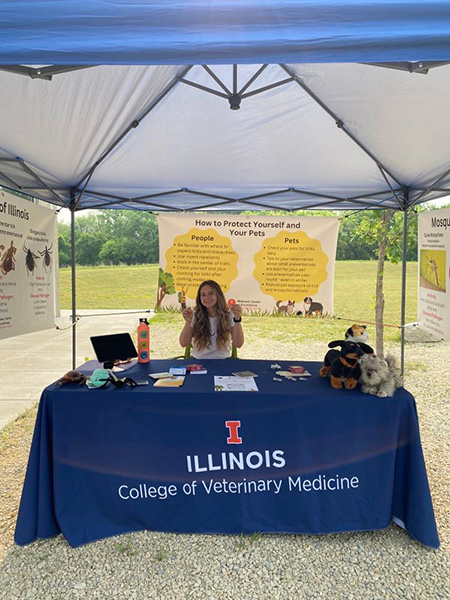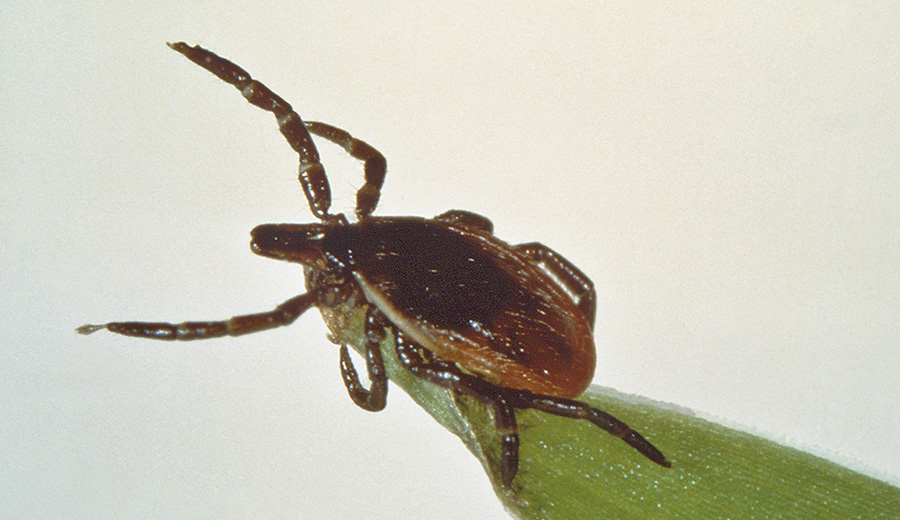They crawl on your shoes as you hike. They burrow in your scalp. They crawl around in the hair of your dog and nestle in the skin of your cat. “They” are ticks!
Every veterinary clinic around the United States preaches tick prevention. But why does it matter? Holly Black, a third-year veterinary student at the University of Illinois College of Veterinary Medicine, explains how preventing tick bites protects the health of both the furry and the human members of your family.
| Participate in Our Tick & Mosquito Survey |
| We’re studying tick and mosquito exposure in Illinois. If you live in Illinois, please complete our survey! |
Black, who is also pursuing a master’s in public health degree, conducts research on tick and mosquito exposure in Illinois working in the laboratory of Dr. Becky Smith. Dr. Smith, a veterinary epidemiologist, uses data analysis and mathematical modeling to develop strategies for predicting and preventing the spread of disease.

A Closer Look at Ticks
You may find some of Black’s tick facts surprising. “Ticks are commonly thought of as insects,” she says, “but actually they are arachnids, with eight legs like spiders and mites. They undergo four life stages—egg, larva, nymph, and adult—with the total life cycle taking around two years.” Ticks live in wooded areas, grasslands, and even piles of leaves.
Ticks must attach themselves to a host and feed on a meal of blood to progress from one life stage to the next and to reproduce. The host could be a person, a pet, livestock, or wildlife.
“A behavior called questing is one way ticks locate a host,” Black explains. “Questing ticks position themselves on vegetation, such as blades of grass, with their front legs extended, waiting for a host to come by to grab onto.”
(The image at the top of the page, courtesy of the Centers for Disease Control and Prevention image library, shows a questing tick.)
The Ticks of Illinois
Five kinds of ticks of veterinary concern make their home in Illinois: the American dog tick, the lone star tick, the blacklegged tick, the Gulf Coast tick, and the brown dog tick. Additionally, in 2024, the Asian longhorned tick made its first appearance in our state. Each species, at its mature adult stage, has a distinct active season and environment.
“While the American dog tick is most active during the early spring through late summer, the blacklegged tick is most active during the fall and can be present throughout winter and spring as well,” Black states. “The brown dog tick is active all year round.”
The American dog tick is found in fields and open grass, whereas the brown dog tick is found anywhere there are dogs, from kennels to your living room.
Ticks Carry Disease

According to Black, not every tick is infected with a pathogen. “Tick density and infection prevalence vary throughout the United States,” she says. “However, where there are ticks, there is risk.” Any tick could carry and spread disease. Tick-borne diseases include Lyme disease, anaplasmosis, Rocky Mountain spotted fever, and ehrlichiosis.
These diseases cause different signs and symptoms depending on the species that is infected. “Dogs and cats infected with a tick-borne illness may present with fever, loss of appetite, depression, lethargy, joint stiffness, neurological problems, enlarged lymph nodes, or vomiting,” explains Black. Horses are prone to anaplasmosis, which presents as limb swelling and bleeding. Cattle experience severe blood loss from severe tick infestations in addition to tick-borne diseases.
“It is important to note that dogs, cats, and horses may also be asymptomatic,” she says. “Tick-borne diseases can be deadly, but veterinarians are equipped to treat most tick-borne infections. Early diagnosis is key.”
Tick Prevention
While animals that spend time outdoors are most at risk of tick-borne illness, they aren’t the only ones. “Even indoor pets can encounter ticks. Ticks can enter the home through cracks in doors or by riding in on a human or pet that spends time outside,” says Black. For this reason, all pets may need tick prevention.
“Treating your pets with year-round tick prevention is a great way to protect them from tick-borne diseases,” she states. Tick prevention products come as collars, chewable tablets, and topicals.
Black also advises doing “tick checks” on yourself and your pets. “Ticks seek out crevices and places that are hard to find, such as under the collar, in the ears, between the toes, and between the legs,” she explains.
Keeping ticks off your pets benefits human family members too. “Tick-borne diseases can cause serious health problems for people and animals. Keeping ticks off our pets and out of our homes is crucial to minimizing the risk of infection,” says Black.
By Lauren Bryan




